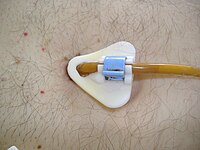
Photo from wikipedia
Since the introduction of transanal endoscopic microsurgery, local excision of "early" rectal lesions has offered the possibility to reduce the invasiveness of treatment for the limited disease. Flexible endoscopy techniques… Click to show full abstract
Since the introduction of transanal endoscopic microsurgery, local excision of "early" rectal lesions has offered the possibility to reduce the invasiveness of treatment for the limited disease. Flexible endoscopy techniques allow today different alternatives consisting of endoscopic mucosal resection or endoscopic submucosal dissection. The first is a straightforward and relatively easy technique, but it prevents a correct pathological staging of the lesion due to fragmentation and the verification of disease-free margins. The second relies on operators' audacity depending on their increasing experience due to the limited progress in technology. What is the preferable technique today is questionable. All the methods have pros and cons. The future certainly will see the use of ideal systems, allowing the possibility of precision surgery for partial- or full-thickness excision, depending on intraoperative findings, and the extension above the rectosigmoid junction. Miniaturized flexible robotic devices may represent the solution for both issues.
Journal Title: Clinics in colon and rectal surgery
Year Published: 2022
Link to full text (if available)
Share on Social Media: Sign Up to like & get
recommendations!